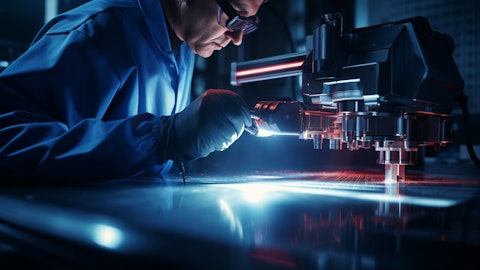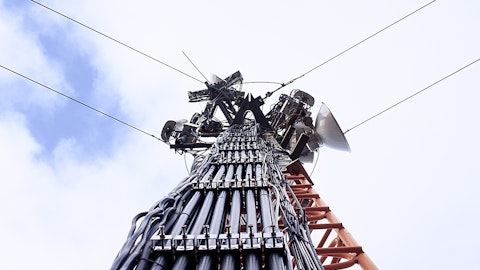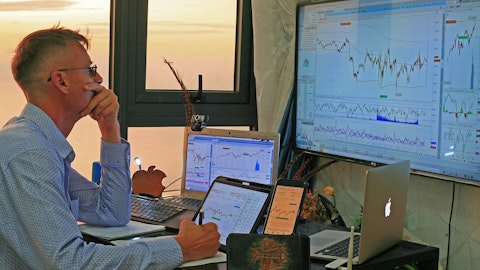Q – Samik Chatterjee: Thank you. Thanks for taking my questions.
Kathy Ta: Thanks, Samik.
Operator: Our next question today comes from Christopher Rolland from SIG. Your line is now open. Please go ahead.
Q – Christopher Rolland: Hey, guys. Thanks for the question. Mine is about Cloud Light. So, first of all, you talked about maybe the end of program and a dip in June and September. If you could kind of describe why that program just ends and why there isn’t something fluid into the segment of AI or what have you? And then, you talked about a broadening into new customers. How many are you thinking and how large do you think they may be versus your primary customer? Thank you.
Wajid Ali: Yes, Chris, I mean, we do, as you’re alluding to have a degree of customer concentration in the Cloud Light business. So, the customer that’s driven a lot of 800 gig growth over the past several quarters, there’s a time to ramp down of the current generation of product and takes time to ramp up the next generation of product. So, while there are other customers and other customers are growing, they’re not sufficient to offset that product transition, if you will. And as Alan alluded to, we are, through the capacity expansions as well as new product activities, expanding the number of sockets that we have with multiple customers so that such product transitions, which do occur time to time, will be more smoothed out as the revenue base grows and diversifies.
In terms of the magnitude of other customer opportunities, certainly, as we talked about when we announced the acquisition of Cloud Light, I mean, this is a very large market, and so the opportunity to add multiples of current revenue in the coming years is certainly well ahead of us and very well positioned with both the Cloud Light capabilities, then you add what momentum brings to the table. Customers, to-date, are very encouraged by the possibilities and are working closely with us to bring that to a reality over the coming year. You can’t develop a product, qualify it, and ramp it in a few quarters. That does take a little bit of time, and so that’s why we’re talking about having significant capacity additions and revenue growth later this calendar year.
Alan Lowe: Yes, and Chris, maybe I can add to that as well.
Christopher Rolland: Yes.
Alan Lowe: Yes, just to add to that, I think given that we’re a U.S. headquartered company and now investing heavily outside of China is a very attractive alternative U.S. partner to all of the cloud customers, as well as the cloud infrastructure companies. And so, that’s what’s really got our attraction with, I’d say, every one of the customers. And that’s why we’re investing strongly in Thailand and will continue to invest to meet the needs of the demands that our customers are asking for. Because when they say go, they want to make sure we have the capacity in place. And so, that’s what gives us confidence and why we’re investing so strongly.
Christopher Rolland: Thank you, Alan. Maybe as a follow-up, just to understand some of these moving product dynamics, when will 100-gig VCSELs be meaningful for you in terms of revenue? And then it sounds like you don’t have a roadmap for 200-gig VCSELs, you’ll have a hard cut to SIFO or EMLs for 200-gig, and that will be going into Cloud Light products as well. Did I get that transition correct?
Alan Lowe: Sort of, I would, say today our 100-gig VCSELs have a lot of positive feedback. We’ll start revenue in the second-half of the calendar year, we will be meaningful in calendar ’25, both from an AOC standpoint as well as a multimode SR transceiver. We do have 200-gig on our roadmap. We are doing development work and the progress that we made over the last year on 100-gig gives us a lot of confidence that we will have a 200-gig at the right time, and that’s probably end of 2025 and into 2026. So, 100-gig VCSELs have a very nice runway through 2025 and I think our confidence in our 200-gig roadmap is very strong. So, we will have both — [multiple speakers] that will hit first, EMLs as well around the same time at the 200-gig per lane, and then VCSELs, 200-gig. We’ll come after that.
Christopher Rolland: Thanks, Alan. Thanks, guys.
Kathy Ta: Thanks, Chris.
Operator: Our next question comes from Meta Marshall from Morgan Stanley. Your line is now open.
Meta Marshall: Thanks. It’s been touched on a couple of questions, but just wanted to kind of narrow down into kind of the process or timeline of bringing your lasers into the Cloud Light portfolio, just kind of what the timing of that vertical integration would be, and then maybe just as a second question, more on the 3D sensing side of the portfolio, there are new kind of devices out from your major customer, just anything in terms of kind of contextualizing how big that opportunity either is or could contribute to the things.
Alan Lowe: Yes, so the timing of our lasers into Cloud Light’s portfolio in the lab, certainly they’re already there in the short period that we’ve been one company, both on 100-gig VCSELs as well as EMLs. So, then it’s just a matter of — customers don’t want to do changes in existing products and so it will come up as we get new product qualifications and new customers and new opportunities. And so, I would say that it’s all dependent upon how fast those qualifications happen. But I would say that, that would be really a second-half of calendar ’24 and into ’25 in a more meaningful way. 3D sensing new devices, they’re very secretive. We believe we are in some of their new devices, but quite frankly, the volumes of those devices are very small relative to handsets. So, I don’t think you should model any meaningful contribution on those new devices in the short term.
Kathy Ta: Great. Thank you. Thanks, Meta.
Operator: Our next question today is from Karl Ackerman from BNP Paribas. Your line is now open. Please go ahead.
Karl Ackerman: Yes, good morning. I have a question for Alan and one for Wajid. Wajid within telecom, 130 and 200 gigabaud and coherent optics with eventually your own coherent DSP, that appear to be growth drivers for you, but where do you think your customers are on digesting inventory? I know you indicated it may not recover until September quarter, but have you seen book-to-bill trough in that area of the business? Any color on that would be helpful as we think about the recovery in telecom.
Alan Lowe: Yes, so on the high gigabaud products, those are constrained by our ability to meet customer demand today. And you’re right, I think the combination of 130 gigabaud and 200 gigabaud and our own DSP is a real winning solution to meet the needs of next generation ZR products, as well as the long-haul and metro products. So, today, our 200 gigabaud and 130 gigabaud are going into more metro and long haul applications, just as prior products, and prior generations, as they cost reduce over time and get into a smaller form factor into ZR products. So, that is off into the races, and it feels like the old times, the number of emails I get from executives asking us to ramp up faster and work with our suppliers to get product to them when they need it.
So, that’s a very, very strong positive. As far as digestion is concerned, I’d say that we have a lot of single source or primary source products that during the pandemic were in short supply where customers ordered in anticipation. And for example, our tunable laser that came from Neophotonics is the workhorse of the industry and there’s inventory at many of our customers of those products as the anticipation of ZR demand was very, very strong and it became less so over the horizon. So, inventory needs to be digested of tunable lasers and when that goes away, we believe that will take another quarter and a half or so that those products will ramp back up. So, I think putting aside the short-term inventory glut, we’re very well positioned on existing products, on new products, and the new product demand is very strong.
So, I think from that perspective, we’re very confident in our position and the market share today and going forward.
Karl Ackerman: Thank you for that, Alan. Maybe a follow-up, you indicated how you are expanding production capacity in Thailand for high-speed laser components. At the same time, there seems to be quite a strong willingness by your customers to accept that. So, are you seeing a willingness across the supply chain for your customers to co-invest in your capacity as they ready some of these very high-capable products, really for AI clusters and next-generation AI networks as they wait for that demand? Thank you.
Alan Lowe: I would say on existing capacity and short-term growth of capacity, that’s on our dime and our customers are encouraging us and will reward us over time with orders. They’re investing their R&D and engineering resources to qualify our products in the short term. I would say that we are getting co-investment on development projects to develop unique alternatives to transceivers. So, for the long term, I think we have a share of mind with some of the AI infrastructure companies around what does the next generation of Datacom or optical interconnect or GPUs, et cetera, what does it look like? And they’re willing to help us make those investments that will turn into revenue a little bit further out. But they’re clearly partnering with us because they see the breadth of technology and capabilities that we have. So, I’d say that’s kind of the answer both from the short-term as well as longer-term. Does that answer your question, Karl?
Karl Ackerman: Yes, it does. Thank you.
Alan Lowe: All right.





